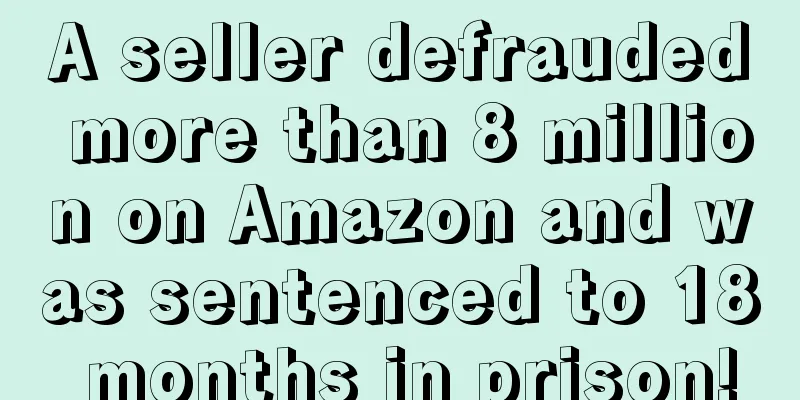The tariff threshold has helped Chinese sellers to attack Amazon! After local businesses were eroded, the United States began to get anxious

|
Chinese sellers have always been the top players on Amazon. Last year, Amazon's revenue reached a staggering $21 billion, and Chinese sellers contributed the vast majority. Currently, Chinese sellers account for about 40% of Amazon's total sales, and 75% of new sellers on Amazon are from China. In Amazon's domestic market in the United States, the market share of domestic manufacturers and retailers is being eroded by the influx of Chinese sellers. What supports Chinese sellers to capture Amazon's US market is the direct support of China's domestic policies and the indirect promotion of US customs policies. It is understood that Beijing has massively subsidized its state-owned factories, which enables them to keep costs down and gain price advantages. In addition, a 2016 change in U.S. customs law has helped more Chinese products be exported to the United States through Amazon, avoiding U.S. tariffs, taxes and regulatory oversight. With the influx of Chinese sellers on Amazon, the United States is beginning to realize that unless Congress takes action, Amazon will continue to help Chinese companies grab more market share from American manufacturers. Changes in U.S. tariff thresholds The U.S. Customs has set a "minimum value" tariff threshold for goods shipped from abroad to the U.S., below which goods will be exempt from tariffs and avoid the complicated customs inspection process. The purpose of the U.S. setting this threshold is to save the federal government the work of assessing small, inexpensive items mailed from overseas. In the 1930s, the threshold was set at $1 and gradually increased to $5 in the 1990s. However, in 2016, the threshold was abruptly raised by Congress to $800. As for why the price suddenly increased so much, some analysts said that this was a lie woven by Amazon and express carriers for their own benefit, saying that they could bring in large quantities of consumer goods while avoiding traditional customs deposits, tariffs and taxes. With the explosive growth of e-commerce sales, Amazon and other online retailers have been able to increase their sales and profits exponentially. Amazon's sales revenue totaled more than $386 billion last year. In addition, about 52% of Amazon's sellers are in China, which means that Amazon is channeling a lot of money to Chinese companies. A large number of Chinese goods are exploiting loopholes through Amazon The growth in inbound goods has been fueled by changes to the U.S. “minimum value” tariff threshold that have eliminated much of the scrutiny that has long gone into products imported into the U.S. every day. Data from the U.S. Customs and Border Protection in fiscal year 2020 shows that there were 768 million cheap, light and small shipments entering the United States. In just the third month of the current Customs fiscal year 2021, the agency has tracked 662 million cheap, light and small shipments. This is an astonishing growth rate. Amazon's large volume of imported small packages means goods are shipped directly to American consumers from unknown overseas suppliers, making it impossible for regulators to oversee them and circumventing the U.S.'s 25% tariff on Chinese goods. The fact is that as long as foreign suppliers say their goods are worth less than $800, their products face no U.S. taxes or tariffs, making it nearly impossible for U.S. brick-and-mortar retailers to compete fairly with Amazon. At the same time, this also means that a large number of potentially dangerous or counterfeit products arrive in the United States every day. It is understood that more than 90% of the counterfeit goods seized in the United States are transported by international mail and express delivery, and 83% of them come from China. Local manufacturers and retailers hit In addition to eating into the market share of local retailers in the United States, the tariff threshold set by China's customs for foreign goods is only 50 yuan (7.82 U.S. dollars), which is in stark contrast to the current 800 U.S. dollars offered by the United States. The rewards obtained by Chinese sellers have also caused a "psychological imbalance" in the U.S. market. The US media pointed out that the above phenomenon is disastrous for domestic manufacturers and retailers. Congress should immediately restore the US minimum value standard to an amount that Americans truly consider to be "low value". Adjusted for inflation, the old $5 level would be $9 today, which is still higher than China's rate and completely reasonable. Some say that if Congress fails to address the problem, the damage will spread to the turf of major U.S. manufacturers and retailers. Editor ✎ Xiao Zhu/ Disclaimer: This article is copyrighted and may not be reproduced without permission. |
Recommend
What is Letaobang? Letaobang Review
LeTaoBang (Jiangmen LeTao Technology Service Co., ...
After the "account scanning incident", sellers usher in spring! Amazon's welfare policies are coming one after another
Just as the scanning of numbers chilled the hearts...
Etsy announces second quarter 2022 financial report! 6 million new buyers!
<span data-docs-delta="[[20,"获悉,7月27日,Etsy...
Primeday registration begins! Alternative event date confirmed
Originally, Primeday was going to be postponed due...
"Strategic defense" in 2020! The secret to annual sales of over 100 million yuan is to choose the right track
Today, the cross-border e-commerce seller we inter...
What is UangTeman? UangTeman Review
UangTeman was founded in April 2015. The company m...
What is Fiverr? Fiverr Review
Fiverr is a task crowdsourcing platform, and the t...
Are Amazon sellers still worried about reviews? Try Facebook chatbots
How to obtain reviews has always been a difficult...
Sellers' costs soar! UPS announces peak season surcharges and a 5.9% price increase across the board next year!
According to foreign media reports, UPS recently a...
Shopify and DreamRobot have reached a cooperation! It is convenient for sellers to manage orders from multiple platforms!
It is learned that according to foreign media repo...
Klarna releases first half and Q2 results, CEO says ready for IPO at any time
It is learned that on August 31, BNPL payment gian...
What is groupalia? Groupalia Review
Groupalia's main business is in Spain. It offe...
What is Video Pass? Video Pass Review
Videotong, video official website, global startup,...
What is Meihuan International Warehousing and Logistics? Meihuan International Warehousing and Logistics Review
Meihuan (Shanghai) E-commerce Co., Ltd. is a servi...
What is Kuaifang Medicine Delivery? Kuaifang Medicine Delivery Review
Kuaifang Medicine Delivery is a mobile application...






![[DNY123 Cross-border Morning News] Lazada and Cainiao jointly launched cross-border express delivery service, Vietnam revised the cross-border e-commerce law](/upload/images/67e6e80f56482.webp)


